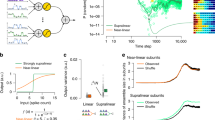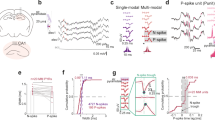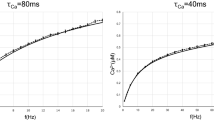Abstract
Traditionally, neuronal operations in the cerebral cortex have been viewed as occurring through the interaction of synaptic potentials in the dendrite and soma, followed by the initiation of an action potential, typically in the axon1,2. Propagation of this action potential to the synaptic terminals is widely believed to be the only form of rapid communication of information between the soma and axonal synapses, and hence to postsynaptic neurons. Here we show that the voltage fluctuations associated with dendrosomatic synaptic activity propagate significant distances along the axon, and that modest changes in the somatic membrane potential of the presynaptic neuron modulate the amplitude and duration of axonal action potentials and, through a Ca2+-dependent mechanism, the average amplitude of the postsynaptic potential evoked by these spikes. These results indicate that synaptic activity in the dendrite and soma controls not only the pattern of action potentials generated, but also the amplitude of the synaptic potentials that these action potentials initiate in local cortical circuits, resulting in synaptic transmission that is a mixture of triggered and graded (analogue) signals.
This is a preview of subscription content, access via your institution
Access options
Subscribe to this journal
Receive 51 print issues and online access
$199.00 per year
only $3.90 per issue
Buy this article
- Purchase on Springer Link
- Instant access to full article PDF
Prices may be subject to local taxes which are calculated during checkout




Similar content being viewed by others
References
Stuart, G., Schiller, J. & Sakmann, B. Action potential initiation and propagation in rat neocortical pyramidal neurons. J. Physiol. (Lond.) 505, 617–632 (1997)
Mainen, Z. F., Joerges, J., Huguenard, J. R. & Sejnowski, T. J. A model of spike initiation in neocortical pyramidal neurons. Neuron 15, 1427–1439 (1995)
Awatramani, G. B., Price, G. D. & Trussell, L. O. Modulation of transmitter release by presynaptic resting potential and background calcium levels. Neuron 48, 109–121 (2005)
Nicholls, J. & Wallace, B. G. Quantal analysis of transmitter release at an inhibitory synapse in the central nervous system of the leech. J. Physiol. (Lond.) 281, 171–185 (1978)
Shimahara, T. & Tauc, L. Multiple interneuronal afferents to the giant cells in Aplysia. J. Physiol. (Lond.) 247, 299–319 (1975)
Shapiro, E., Castellucci, V. F. & Kandel, E. R. Presynaptic membrane potential affects transmitter release in an identified neuron in Aplysia by modulating the Ca2+ and K+ currents. Proc. Natl Acad. Sci. USA 77, 629–633 (1980)
Ivanov, A. I. & Calabrese, R. L. Modulation of spike-mediated synaptic transmission by presynaptic background Ca2+ in leech heart interneurons. J. Neurosci. 23, 1206–1218 (2003)
Storm, J. F. Temporal integration by a slowly inactivating K+ current in hippocampal neurons. Nature 336, 379–381 (1988)
Debanne, D., Guerineau, N. C., Gahwiler, B. H. & Thompson, S. M. Action-potential propagation gated by an axonal IA-like K+ conductance in hippocampus. Nature 389, 286–289 (1997)
Cox, C. L., Denk, W., Tank, D. W. & Svoboda, K. Action potentials reliably invade axonal arbors of rat neocortical neurons. Proc. Natl Acad. Sci. USA 97, 9724–9728 (2000)
Koester, H. J. & Sakmann, B. Calcium dynamics associated with action potentials in single nerve terminals of pyramidal cells in layer 2/3 of the young rat neocortex. J. Physiol. (Lond.) 529, 625–646 (2000)
Sanchez-Vives, M. V. & McCormick, D. A. Cellular and network mechanisms of rhythmic recurrent activity in neocortex. Nature Neurosci. 3, 1027–1034 (2000)
Shu, Y., Hasenstaub, A. & McCormick, D. A. Turning on and off recurrent balanced cortical activity. Nature 423, 288–293 (2003)
Shu, Y., Hasenstaub, A., Badoual, M., Bal, T. & McCormick, D. A. Barrages of synaptic activity control the gain and sensitivity of cortical neurons. J. Neurosci. 23, 10388–10401 (2003)
Hasenstaub, A. et al. Inhibitory postsynaptic potentials carry synchronized frequency information in active cortical networks. Neuron 47, 423–435 (2005)
Steriade, M., Timofeev, I. & Grenier, F. Natural waking and sleep states: a view from inside neocortical neurons. J. Neurophysiol. 85, 1969–1985 (2001)
Steriade, M., Nunez, A. & Amzica, F. A novel slow (< 1 Hz) oscillation of neocortical neurons in vivo: depolarizing and hyperpolarizing components. J. Neurosci. 13, 3252–3265 (1993)
Dorval, A. D., Christini, D. J. & White, J. A. Real-time linux dynamic clamp: a fast and flexible way to construct virtual ion channels in living cells. Ann. Biomed. Eng. 29, 897–907 (2001)
Binzegger, T., Douglas, R. J. & Martin, K. A. Axons in cat visual cortex are topologically self-similar. Cereb. Cortex 15, 152–165 (2005)
Binzegger, T., Douglas, R. J. & Martin, K. A. A quantitative map of the circuit of cat primary visual cortex. J. Neurosci. 24, 8441–8453 (2004)
Gilbert, C. D. & Wiesel, T. N. Clustered intrinsic connections in cat visual cortex. J. Neurosci. 3, 1116–1133 (1983)
Markram, H., Lubke, J., Frotscher, M., Roth, A. & Sakmann, B. Physiology and anatomy of synaptic connections between thick tufted pyramidal neurones in the developing rat neocortex. J. Physiol. (Lond.) 500, 409–440 (1997)
Peters, A. & Jones, E. G. (eds) Cerebral Cortex Vol. 1 (Plenum Press, New York, 1984)
Jackson, M. B., Konnerth, A. & Augustine, G. J. Action potential broadening and frequency-dependent facilitation of calcium signals in pituitary nerve terminals. Proc. Natl Acad. Sci. USA 88, 380–384 (1991)
Geiger, J. R. & Jonas, P. Dynamic control of presynaptic Ca2+ inflow by fast-inactivating K+ channels in hippocampal mossy fiber boutons. Neuron 28, 927–939 (2000)
McCormick, D. A. Neurotransmitter actions in the thalamus and cerebral cortex and their role in neuromodulation of thalamocortical activity. Prog. Neurobiol. 39, 337–388 (1992)
Carandini, M. & Ferster, D. A tonic hyperpolarization underlying contrast adaptation in cat visual cortex. Science 276, 949–952 (1997)
Sanchez-Vives, M. V., Nowak, L. G. & McCormick, D. A. Membrane mechanisms underlying contrast adaptation in cat area 17 in vivo. J. Neurosci. 20, 4267–4285 (2000)
Welch, K. M. Contemporary concepts of migraine pathogenesis. Neurology 61, S2–S8 (2003)
Fricker, D., Verheugen, J. A. & Miles, R. Cell-attached measurements of the firing threshold of rat hippocampal neurones. J. Physiol. (Lond.) 517, 791–804 (1999)
Alle, H. & Geiger, J. R. P. Combined analog and action potential coding in hippocampal mossy fibers. Science 311, 1290–1293 (2006)
Acknowledgements
This work was supported by the NIH (D.A.M.), the Howard Hughes Foundation (A.H.) and the Kavli Institute for Neuroscience. Author Contributions Y.S. performed all recordings, A.H. analysed the data, A.D. did cell reconstructions, Y.Y. performed computational models, and D.A.M. wrote the paper and helped design experiments. All authors discussed the results and commented on the manuscript.
Author information
Authors and Affiliations
Corresponding author
Ethics declarations
Competing interests
Reprints and permissions information is available at npg.nature.com/reprintsandpermissions. The authors declare no competing financial interests.
Supplementary information
Supplementary Notes
This file contains the Supplementary Introduction, Supplementary Methods, Supplementary Figures and Supplementary Results. (DOC 800 kb)
Rights and permissions
About this article
Cite this article
Shu, Y., Hasenstaub, A., Duque, A. et al. Modulation of intracortical synaptic potentials by presynaptic somatic membrane potential. Nature 441, 761–765 (2006). https://doi.org/10.1038/nature04720
Received:
Accepted:
Published:
Issue Date:
DOI: https://doi.org/10.1038/nature04720
This article is cited by
-
Overexpression of KCNN4 channels in principal neurons produces an anti-seizure effect without reducing their coding ability
Gene Therapy (2024)
-
Immediate reuse of patch-clamp pipettes after ultrasonic cleaning
Scientific Reports (2024)
-
Diversity and Functional Features of Calcium-Dependent Potassium Channels as Determinants of Their Role in the Plasticity of Cerebral Neurons
Neuroscience and Behavioral Physiology (2021)
-
Background calcium induced by subthreshold depolarization modifies homosynaptic facilitation at a synapse in Aplysia
Scientific Reports (2020)
-
An axon-specific expression of HCN channels catalyzes fast action potential signaling in GABAergic interneurons
Nature Communications (2020)
Comments
By submitting a comment you agree to abide by our Terms and Community Guidelines. If you find something abusive or that does not comply with our terms or guidelines please flag it as inappropriate.



